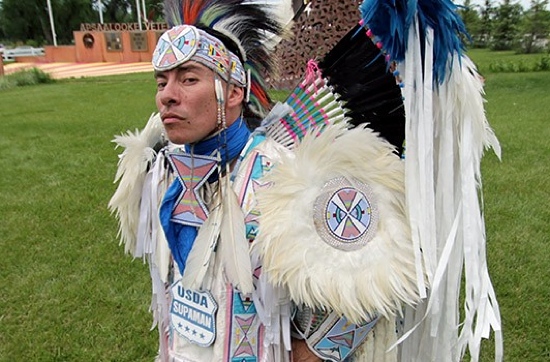Urban traditions on display at Folk Festival
Folk traditions have to start somewhere. Here are people making new ones endure.

Christian Takes Gun Parrish had two performances scheduled during an American Indian Heritage Day years ago in Montana. The Crow Nation member first performed Fancy Dance, a contemporary style of powwow dancing in elaborate Pan-Indian regalia.
However for his second stage appearance, he’d return in civilian clothes to rap. But he didn’t have to time change, so he rapped in the traditional regalia he had on. The crowd loved it and Parrish, known as Supaman, has performed that way since.
“I perform in my outfit to show that we as Native Americans walk in two worlds, and it’s good to embrace both,” Parrish said via email. Performing hip-hop for roughly 10 years, Parrish relates to the “culture of hip-hop and the environment where hip-hop evolved from. I feel that a lot of Native Americans see the similarities between the ghetto and the reservations.”
Parrish is one five performers included in the Celebrating Urban Traditions showcase of the Richmond Folk Festival, which highlights several modern customs that’ve emerged from American cities.
— ∮∮∮ —
Boston breakdancer Anthony DeMarco has helped assemble the Throwdown on Brown, a series of invitational competitions featuring Richmond-area breakdancers.
“Breakdancing emerged out of a new culture in the 1970s, called hip-hop, born out of the need for inner city youth to find identity,” said DeMarco via email. DeMarco’s run the Boston BBoy website for 10 years and has taught breaking for the last 15 years. “The beautiful thing about hip-hop is that it allows anyone, from any race or income level, to express oneself out of nothing at little or no cost.”
Starting as a counter-culture offshoot of hip-hip, breakdancing is now global. “Breakdancing (bboying/bgirling) has evolved to a point where it’s been internationally recognized to the point where it’s being considered for the Olympics,” DeMarco said. “The moves, style, attitude, acumen, and level of difficulty have increased exponentially.”
https://www.youtube.com/watch?v=VZ0lTO2EVYw
A prevalent misconception about breakdancing, DeMarco said, is that breakdancers aren’t intelligent, can’t hold down jobs, and run with gangs, all connotations that miss the point. “Breakdancing is a beautiful display of physical attributes and timing that convey intense emotion and skill. It’s meant to resemble a fight, without contact,” DeMarco said. “The only thing that gets bruised is an ego.”
— ∮∮∮ —
Just before breakdancing broke in the streets of New York City, go-go music emerged in the Nation’s Capital in the 1960s and 1970s as a spin-off of funk. The godfather of go-go, Chuck Brown, inspired the band Trouble Funk, who became global go-go evangelizers, to adopt the sound in the late-1970s.
“Real go-go has to be performed live,” said ‘Big’ Tony Fisher, frontman of the 35-year-old group. “It’s a lot of percussion, and a lot of improv and crowd participation. That’s what go-go music is all about.”
Chuck Brown created the genre, but Trouble Funk distributed it worldwide. “We introduced it to the world,” Fisher said. The band has routinely traveled to England, Japan, Italy, France, and Spain for years. “They love it,” Fisher said. “A lot of people accept it as good funky music. Trouble Funk is just that.”
The band is one of several audience favorites from past Richmond Folk Festivals returning to help celebrate the festival’s 10th year. “Richmond has always shown Trouble Funk love since the mid-70s,” Fisher said. “All together, we rock the house.”
“I’m looking forward to dropping some bombs.”
-
Recommend this
on Facebook -

Report an error
-

Subscribe to our
Weekly Digest





There are no reader comments. Add yours.